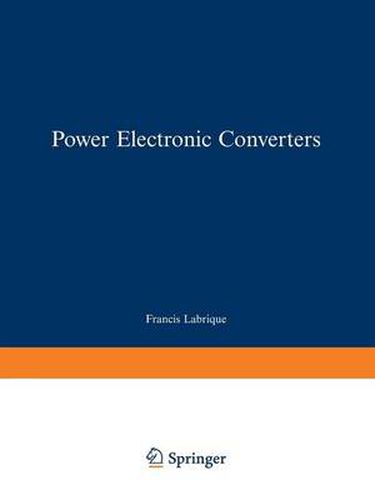Power Electronic Converters: DC-AC Conversion
Guy Seguier,Francis Labrique

Power Electronic Converters: DC-AC Conversion
Guy Seguier,Francis Labrique
This title is printed to order. This book may have been self-published. If so, we cannot guarantee the quality of the content. In the main most books will have gone through the editing process however some may not. We therefore suggest that you be aware of this before ordering this book. If in doubt check either the author or publisher’s details as we are unable to accept any returns unless they are faulty. Please contact us if you have any questions.
This is the final volume in a four-volume series concerning POWER ELEC TRONIC CONVERTERS. The first volume studies AC/DC conversion, the second studies AC/ AC conversion, and the third DC/DC conversion. This final volume deals with DC/AC conversion, i.e. with inverters. At the output of an inverter fed by a DC voltage supply, this voltage is alternatively found with one polarity and then with the other; in other words, an AC voltage made up of square pulses is obtained. Filtering must be carried out if, as is normally the case, a virtually sinusoidal voltage is required: this problem of filtering underlies the entire study of inverters. In some applications, the load itself provides the filtering. In others, a filter is installed between the inverter and the load; however, as it will be shown in Chap. 2, in cases where the filtered voltage is at industrial network frequency and comprises only a single square-wave pulse per half-cycle, the filter becomes bulky and costly, and the results obtained are poor. Filtering problems explain the considerable development of inverters during the last years: - Firstly there is increasing use of pulse width modulation: each half-cycle is cut up into several pulses of suitable widths; this greatly simplifies filtering. The use of a chopping frequency which is much greater than the frequency of the fundamental components of the inverter output voltage and current has only been made possible by progress in the field of semiconductor devices.
This item is not currently in-stock. It can be ordered online and is expected to ship in 7-14 days
Our stock data is updated periodically, and availability may change throughout the day for in-demand items. Please call the relevant shop for the most current stock information. Prices are subject to change without notice.
Sign in or become a Readings Member to add this title to a wishlist.


